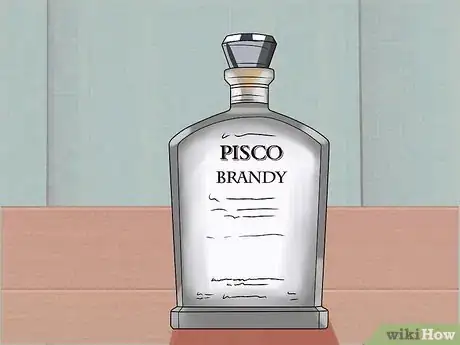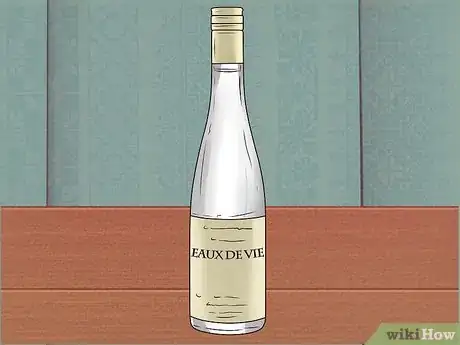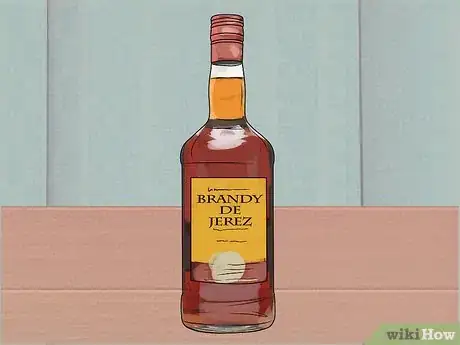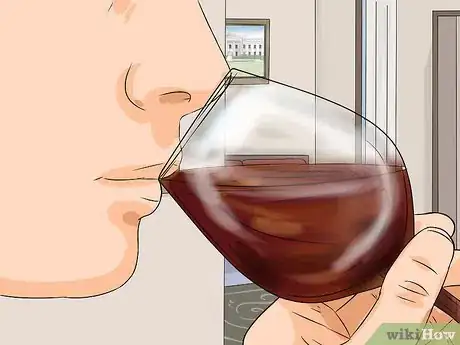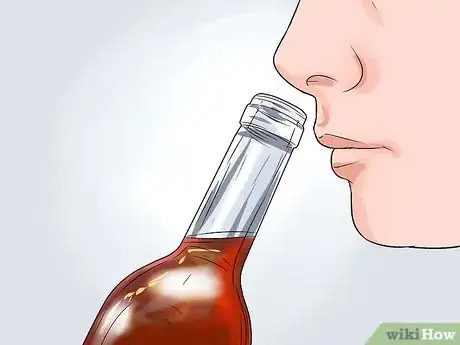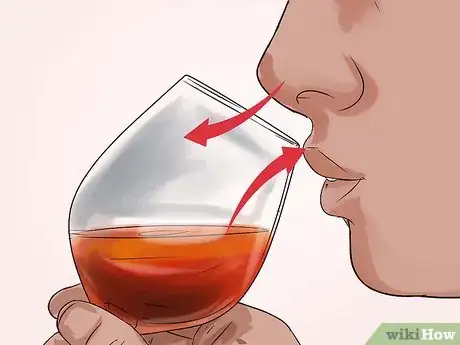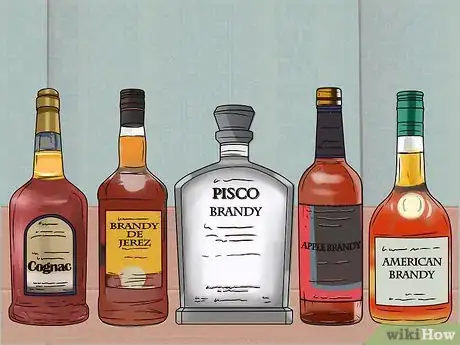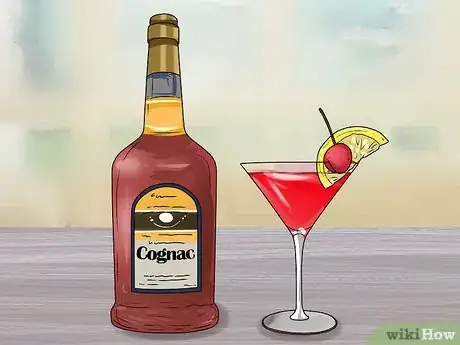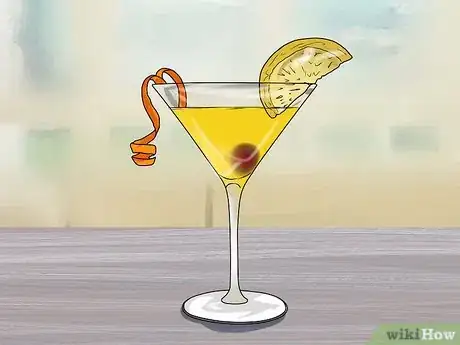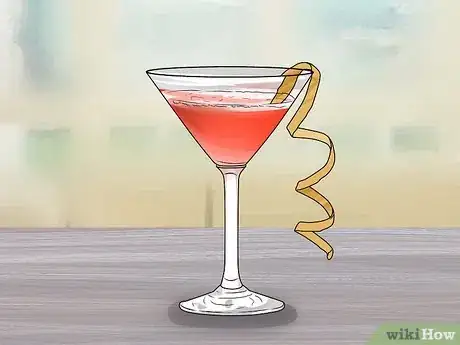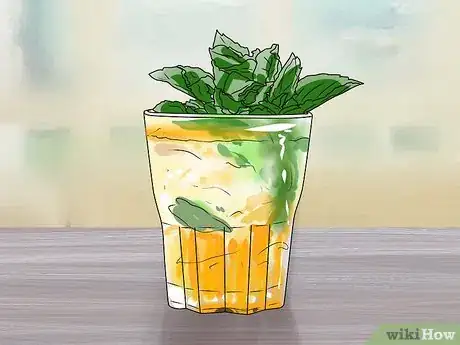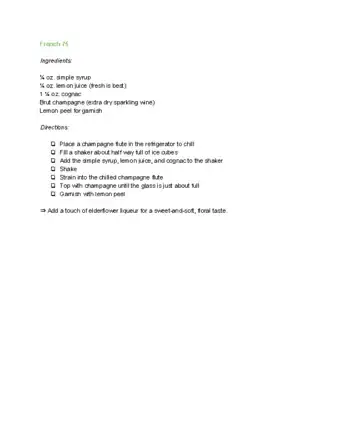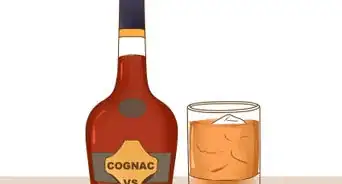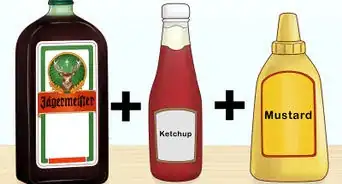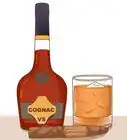This article was co-authored by Bryan Sullivan. Bryan Sullivan is a Bartender and the Owner of Bryan Sullivan Bartending in Seattle, Washington. With over 10 years of experience, he specializes in craft cocktails and has a thorough knowledge of beer, wine, and champagne. He currently holds a MAST Class 12 Mixologist Permit and has provided bar service for 100s of events. Additionally, his business has a 5-star rating and is a listed vendor on The Knot.
There are 16 references cited in this article, which can be found at the bottom of the page.
wikiHow marks an article as reader-approved once it receives enough positive feedback. This article received 19 testimonials and 100% of readers who voted found it helpful, earning it our reader-approved status.
This article has been viewed 916,385 times.
Brandy is wonderful on its own, in a cocktail or as an after-dinner drink. Filled with delicate flavors and aromas, brandy is distilled from wine to produce a spirit that is 35-to-60 percent alcohol by volume. The drink can be enjoyed with some knowledge of its history, the types of brandy and the proper way to drink brandy.
Steps
Learning About and Choosing Your Brandy
-
1Learn how brandy is made. Brandy is any distilled spirit made from fruit juice. The fruit is crushed to get just the juice and then the juice is fermented to make fruit wine. After that, the fruit wine is distilled to produce brandy. The brandy is then usually aged in wooden barrels, although some brandies are not aged.[1]
- Brandy is made from grapes but there are brandies made from other fruits such as apple, peach, plum and many others. When brandy is made from another fruit, the fruit name is said first before the word “brandy.” For example, if made from apples, it would be called apple brandy.[2]
- Brandies get their dark color from aging in barrels. Un-aged brandies will not have this caramel color but colors will often be added to create the same look.[3]
- Pomace brandy is made a bit differently. Instead of just fermenting the grape juice, fermentation and distillation to make pomace brandy will include the skins, stems and seeds of the grapes. Pomace brandy is also known as marc (English and French) and grappa (Italian).[4]
-
2Get an overview of the history of brandy. The name "brandy" originates from the Dutch "brandewijn," or "burnt wine," which evokes the warm, glowing feeling from the first sip of a fine brandy.[5]
- Brandy has been made since the 12th Century but was originally only made by apothecaries and doctors and used as a medicine. French authorities only allowed winemakers to begin distillation in the 16th century.
- The French brandy industry grew slowly until the Dutch began importing brandy for consumption and for export to other European countries. It was cheaper to ship in terms of the amount of alcohol than wine, and so was economically viable for merchants.
- The Dutch invested in building distilleries in the French winemaking areas of the Loire, Bordeaux and Charente. Charente became the most lucrative area for brandy production and is the location of the town called Cognac.[6]
-
3Learn that there are different types of brandies with different rating systems depending on age. Popular types include Armagnac, Cognac, American brandy, pisco, apple brandy, eaux de vie and Brandy de Jerez. Brandies are categorized by age, according to different systems for different types of brandy.[7]
-
4Learn the different aging systems. Brandy is processed in a slow and gentle manner to bring out all its flavors and is traditionally aged in oak barrels. There are different aging systems and categorizations for different kinds of brandy. General aging labels can include AC, VS (Very Special), VSOP (Very Special Old Pale), XO (Extra Old), Hors d’age and vintage but these vary greatly for different types of brandy.[8]
- VS (Very Special) has been aged a minimum of two years. These are best used for mixing as opposed to drinking neat.
- VSOP (Very Special Old Pale) brandy is usually between 4 and a half to six years old.
- XO (Extra Old) brandy are usually six and a half years old or more.
- Hors d’age brandies are too old to determine the age of for some reason or another.
- For some brandies these labels are regulated while for others they are not.
-
5Consider trying Armagnac. Armagnac is a grape brandy named for the region of Armagnac in the southwest of France. It is made from a blend of Colombard and Ugni Blanc grapes and distilled once in column stills. Then it is aged for at least two years in French oak, resulting in a more rustic brandy than Cognac. After aging different aged brandies are blended to make a consistent product.[9]
- 3-star or VS (Very Special) brandy has a youngest brandy in the blend that has aged at least two years in oak.
- VSOP (Very Superior Old Pale) brandy is when the youngest brandy in the blend has aged at least four years in oak, although many of these brandies are actually much older.
- Napoleon or XO (Extra Old) brandy is when the youngest brandy in the blend has aged at least six years in oak.
- Hors d’age brandy is when the youngest brandy in the blend has aged at least ten years.
- If the Armagnac has an age on the label it means that the youngest brandy in the bottle is that age.
- There are also vintage Armagnacs that are at least ten years old and the year of harvest will be displayed on the bottle.
- These age categories only apply to Armagnac; Cognacs and other brandies will have different meanings for these categories.
-
6Consider trying Cognac. Cognac is a grape brandy named for the town of France from which it originates and made from a blend of specific grapes including Ugni Blanc. It has to be distilled twice in copper pot stills and aged in French oak barrels for at least two years.[10]
- 3-star or VS (Very Special) brandy is when the youngest brandy in the blend has aged at least two years in oak.
- VSOP (Very Superior Old Pale) brandy is when the youngest brandy in the blend has aged at least four years, although most brandies in this class are actually much older.
- Napoleon, XO (Extra Old), Extra or Hors d’age brandy is when the youngest brandy in the blend has aged at least six years in oak. On average, these brandies are usually actually 20 years old or more.
- Some Cognacs age 40-50 years in oak.
-
7Consider trying American brandy. American brandy includes many different brands and does not have much legal regulation. Any age categorizing such as VS, VSOP and XO are not legally controlled and you should be aware of this when buying. There are only two U.S. regulations that affect the consumer in terms of the brandy.[11]
- By law if the brandy has not been aged for two years, it must have the word “immature” on its label.[12]
- Additionally by law, if it is not made from grapes then it must say the fruit from which it was made.[13]
- Since classifications are not regulated by law, different brands have different ages for their classifications and their aging processes may not be very long. Check the websites of the distillers for more information on particular varieties and ages.
- There are no legal requirements dictating which distillation techniques should be used.
-
8Consider trying pisco brandy. Pisco is an un-aged grape brandy made in Peru and Chile. Because it is un-aged it is clear in color. There is currently an argument between Peru and Chile over who should be allowed to produce pisco and if it should be restricted to certain regions.
-
9Consider trying apple brandy. Apple brandy is made using apples and comes from either America, where it is called the applejack, or France, where it is called Calvados. It is very versatile and can be used in a range of cocktails.
- The American version, applejack, is very bright and fruity.
- The French version, Calvados, is more nuanced, subtle and layered in flavor.
-
10Consider trying eaux de vie. Eaux de vie are un-aged brandies made from fruits other than grapes such as raspberries, pears, plums, cherries as well as others. They are usually clear because they are un-aged.[14]
- In Germany eaux de vie is called "Schnapps" but this is not at all the same thing as American schnapps.
-
11Consider trying Brandy de Jerez. Brandy de Jerez originates from the Andalusia region in Spain and has its own prescribed production method in which it is only distilled once in copper stills. It is then aged in American oak barrels.
- Brandy de Jerez Solera is the youngest and fruitiest and has a minimum average age of 1 year.
- Brandy de Jerez Solera Reserva has a minimum average age of 3 years.
- Brandy de Jerez Solera Gran Reserva is the oldest of the brandies with a minimum average age of 10 years.
-
12Choose your brandy by type and then age when purchasing. The type can be one of those discussed or it can simply say “brandy”. If it does not have a particular type then look for the country of importation and the source used (for example, grapes, fruit or pomace). Choose by age after you have chosen by type. Remember that general age categories for brandy are very variable and differ according to the type.
Drinking Brandy Neat
-
1Learn what neat means. Drinking brandy “neat” means that you are drinking it by itself with no ice or mixer. You taste only the brandy and nothing else, allowing you to fully experience the flavor.
- Ice will melt and water down the brandy, ruining the flavor.
-
2Drink brandy neat when you have a good quality aged brandy. The best brandies should be savored on their own. This will help you enjoy the flavor fully, heightening your experience and allowing you to truly get a taste of the best brandy experience.[15]
-
3Get a brandy snifter. A brandy snifter or brandy balloon is a short glass with a wide base whose sides taper in at the top. It will have a short stem and come in many sizes, although no more than 2 ounces (60 ml) will usually be served at a time. These glasses are perfect for drinking brandy because they concentrate the subtle aromas at the top of the glass when nosing or smelling them.
- A thoroughly clean snifter that has been air-dried prevents other tastes from interfering with that of the brandy.
-
4Serve immediately. Brandies do not need to breathe like wine does. If you let it sit for too long then some of the volatile alcohols will evaporate. This will lose some of the character of the brandy.
-
5Warm up the glass in your hand. Many connoisseurs prefer to warm up the brandy because gentle heat enhances the flavor and aroma. The best way to do this is to simply hold the glass in your hand to gently warm it up. The wide base of the glass makes it easy to warm in your hand.[16]
- You also can warm the glass by pouring warm water in it and then pouring out before filling with your brandy.
- Another way to warm the brandy is to carefully heat the glass over an open flame.
- Be careful not to overheat! Overheating can cause the alcohol to evaporate and ruin the bouquet and flavor.
- Do not swill the glass because you can lose some of the subtle aromas in the brandy.
-
6Smell the brandy while holding the glass at chest height. Nosing (smelling through your nose) the brandy at this distance will allow you to smell the floral notes and introduces the delicate aromas to your nose. This prevents your senses from being overwhelmed when tasting.
-
7Bring the glass to your chin and smell through your nose again. Raise the snifter to chin height and take a deep breath through your nose. Nosing at this height will let you smell the dried fruit aromas in the brandy.
-
8Raise the snifter to directly under your nose and smell through both your mouth and nose. When you bring the snifter up to your nose you can smell the spice aromas in the brandy. This nosing will be much more complex than the previous two.
-
9Take a very small sip. Your first sip should simply wet your lips so that it does not overpower you. The first sip should be the smallest possible sip and will bring the flavor into your mouth. If you become overpowered it may put you off tasting the brandy again.
-
10Take more sips, starting small and working your way up to bigger sips. These are meant to acclimatize your mouth to the flavor. Only once your taste buds are acclimatized can you fully appreciate the taste of the brandy.
- Drinking brandy is as much about the aroma as it is about the taste so make sure you continue to appreciate the aroma as you sip the brandy.
-
11Start young and move older if you are tasting multiple brandies. If you are tasting a number of brandies then you should start with the youngest first. Always leave a small amount of each to come back to later- you will be surprised how much the first taste can change after your nose and palate have warmed up to the brandies.
-
12Try not to look at the type and cost of the brandy if you are tasting a number of brandies. Both type and price can influence the way you taste a brandy so it is best to cover this information when tasting to really discover the flavors that you like. This can help you learn more about yourself as well.
- You can mark the glasses on the bottom somehow before pouring them. Then mix the glasses up before drinking so that you do not know which is which.
Drinking Brandy Cocktails
-
1Drink brandy in mixed drinks when you have a younger and less expensive brandy. For example, if you have a VS brandy or another unnamed brandy then you can mix these into cocktails. Brandy is part of the wine family so it does not always work well with certain sodas and tonics but there are many good-tasting mixed drinks.
- Although Cognac is an aged, more expensive brandy, it is commonly used in mixed drinks as well.
-
2Consider trying a Sidecar cocktail. The Sidecar is a classic cocktail that the Hôtel Ritz in Paris, France claims to have invented in the early 1900s. You will need 1.5 ounces (45 ml) Cognac, 1 ounce (30 ml) Cointreau or triple sec, .5 ounce (15 ml) fresh lemon juice, a lemon twist for garnish and an optionally sugar for rimming.[17]
- Rim a chilled martini glass with sugar. A martini glass is shaped like an upside down triangle on a long stem. Chill the glass in the freezer and then dip the top rim in a plate of sugar to rim it.
- Pour the ingredients (except the lemon twist) into a cocktail shaker with a few ice cubes and shake vigorously.
- Strain to remove the ice cubes and pour into the glass.
- Garnish with the lemon twist. You can make the lemon twist by peeling off a thin strip of the rind around the lemon in one full circle.
- You can alter the ratio of Cognac, Cointreau and lemon juice a little bit to find the perfect flavor for you.
-
3Consider trying a Metropolitan. A Metropolitan is a classic cocktail whose first recipe is dated 1900. You will need 1.5 (45 ml) ounces brandy, 1 ounce (30 ml) sweet vermouth, .5 tsp simple syrup and 2 dashes Angostura bitters.[18]
- Make a simple syrup by combining 1 cup water with 1 cup superfine sugar in a jar. Seal the jar and shake until the sugar is completely dissolved. Keep the jar in the refrigerator.
- Pour all the ingredients into a cocktail shaker with ice cubes and shake well.
- Strain into a chilled martini glass. A martini glass has a long stem with a cup shaped like an upside-down triangle.
-
4Consider trying a Gentleman’s Hot Toddy. A Hot Toddy is a classic hot drink that has often been historically used as medicine. It can be made with a variety of spirits including brandy and apple brandy. You will require 1 ounce (30 ml) brandy or apple brandy, 1 Tbsp. honey, ¼ lemon, 1 cup water, a pinch of cloves, a pinch of nutmeg and 2 cinnamon sticks.[19]
- Coat the bottom of a mug or Irish coffee glass with honey and then add the brandy or apple brandy and the juice of the ¼ lemon.
- Boil the water in a kettle or pot and pour into the glass.
- Stir the mix and add the cloves and cinnamon sticks.
- Let it sit for 5 minutes and then add nutmeg and enjoy!
- You can alter the ratios of brandy to water. If you are using apple brandy, you may choose to increase the amount of the apple brandy for extra flavor.
-
5Consider trying a Pisco Sour. The Pisco Sour is the most popular way of consuming pisco and is the signature drink of Peru and also very popular in Chile. You will need 3 ounces (95 ml) pisco, 1 ounce (30 ml) fresh squeezed lime juice, ¾ ounce (22 ml) simple syrup, 1 fresh egg white and 1 dash Angostura or Amargo (if you can find it) bitters.[20]
- Make a simple syrup by combining 1 cup water with 1 cup superfine sugar in a jar. Seal the jar and shake until the sugar is completely dissolved. Keep the jar in the refrigerator.
- Combine the pisco, lime, simple syrup and egg white in a cocktail shaker without ice and shake hard until the egg white is foamy, about 10 seconds.
- Add ice and then shake very hard until it is well-chilled, again about 10 seconds.
- Strain the ice out and pour in a chilled pisco sour glass. A pisco sour glass is relatively small and shaped a bit like a normal shot glass, except the base is thinner and the edges spread out a bit more at the top.
- Add the dash of bitters on top of the egg white foam.
-
6Consider trying the Jack Rose. The Jack Rose is a classic cocktail that was very popular in the 1920s that uses applejack, the American type of apple brandy. You will need 2 ounces (60 ml) applejack, 1 ounce (30 ml) lime juice and .5 ounce (15 ml) grenadine. True American applejack is hard to find but if you can get hold of it, try this cocktail.[21]
- Pour the ingredients in a cocktail shaker with ice and shake well.
- Strain into a chilled cocktail glass. This glass will have a long stem with a cup that is shaped like an upside down triangle.
-
7Consider trying the Prescription Julep. This drink first appeared in print in 1857 and combines cognac and rye whiskey for a soothing refresher perfect for summer. You will need 1.5 ounces (45 ml) VSOP cognac or another good brandy, .5 ounce (15 ml) rye whiskey, 2 tsp sugar dissolved in .5 ounce (15 ml) water and 2 sprigs fresh mint.[22]
- Place the sugar and water in a tall glass or julep cup (traditional silver cup) and mix until sugar dissolves.
- Add mint leaves into the glass and gently press to release the flavorful oil. Do not smash up the mint or else you will release bitterness from the leaves.
- Add the brandy and rye whiskey to the glass and stir to combine.
- Fill the glass with crushed ice and stir with a long spoon until the glass begins to get frost on the sides.
- Garnish with a sprig of fresh mint and serve with a straw.
Brandy Terminology and Drink Recipes
Community Q&A
-
QuestionShould brandy be consumed after dinner?
 Community AnswerBrandy is considered an after dinner drink because the strong taste can dull your palate while dining. So yes, it is a good time for consuming brandy.
Community AnswerBrandy is considered an after dinner drink because the strong taste can dull your palate while dining. So yes, it is a good time for consuming brandy. -
QuestionCan I drink brandy with milk?
 Community AnswerDoing so is very common in many countries, add some vanilla -- it's called a tacao (Spanish). Add some brandy in eggnog (milk and eggs) and it's called white tiger's milk (British). Brandy and milk on ice with coffee is brandy or Allen's milk (a major food group in the state of Maine)!
Community AnswerDoing so is very common in many countries, add some vanilla -- it's called a tacao (Spanish). Add some brandy in eggnog (milk and eggs) and it's called white tiger's milk (British). Brandy and milk on ice with coffee is brandy or Allen's milk (a major food group in the state of Maine)! -
QuestionCan I drink brandy over ice?
 Community AnswerYou can, but as it states above, the ice melts and ruins the taste of the brandy. It's best served "neat" (by itself, no ice).
Community AnswerYou can, but as it states above, the ice melts and ruins the taste of the brandy. It's best served "neat" (by itself, no ice).
Warnings
- Consumption of alcoholic beverages impairs your ability to drive a car or operate machinery, and may cause health problems. Always be safe when consuming alcohol.⧼thumbs_response⧽
- Do not drink alcohol if you are pregnant because there is a risk for your baby.⧼thumbs_response⧽
Expert Interview
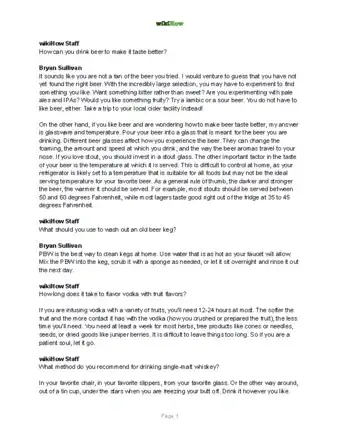
Thanks for reading our article! If you'd like to learn more about drinking brandy, check out our in-depth interview with Bryan Sullivan.
References
- ↑ https://www.distillerytrail.com/blog/what-is-brandy/
- ↑ https://www.distillerytrail.com/blog/what-is-brandy/
- ↑ https://www.wine-searcher.com/grape-2030-brandy
- ↑ http://drinks.seriouseats.com/2013/02/serious-eats-guide-to-brandy-what-is-cognac-armagnac-how-brandy-is-made.html
- ↑ https://www.distillerytrail.com/blog/what-is-brandy/
- ↑ http://drinks.seriouseats.com/2013/02/serious-eats-guide-to-brandy-what-is-cognac-armagnac-how-brandy-is-made.html
- ↑ https://www.distillerytrail.com/blog/what-is-brandy/
- ↑ https://vinepair.com/spirits-101/vsop-meaning-brandy-words/
- ↑ https://vinepair.com/spirits-101/brandy/
- ↑ https://vinepair.com/spirits-101/brandy/
- ↑ https://blog.distiller.com/american-brandy/
- ↑ https://www.law.cornell.edu/cfr/text/27/5.22
- ↑ https://www.law.cornell.edu/cfr/text/27/5.22
- ↑ https://www.thewhiskyexchange.com/c/370/eau-de-vie
- ↑ http://www.brandyandginger.co.za/brandy-insight/drinking-brandy-appreciation-class/
- ↑ https://www.eater.com/drinks/2015/6/12/8769503/getting-to-know-the-brandy-snifter-the-high-brow-glass-for-everyone
- ↑ https://www.seriouseats.com/recipes/2010/11/sidecar-drink-cocktail-recipe.html
- ↑ http://ruhlman.com/2014/06/friday-cocktail-hour-metropolitan/
- ↑ https://www.liquor.com/recipes/hot-toddy/#gs.SzP4dKCM
- ↑ https://www.liquor.com/recipes/pisco-sour/#gs.GTJa0MMu
- ↑ https://www.liquor.com/recipes/jack-rose/#gs.InDNGE0a
- ↑ https://punchdrink.com/recipes/prescription-julep/
About This Article
To drink brandy, try it neat, or with no ice or mixer, if you're drinking a good quality aged brandy. You can also carefully heat the brandy up over an open flame to enhance its flavor and aroma. If you have a younger or less expensive brandy, use it to make cocktails. For example, you could make a metropolitan by mixing brandy, vermouth, simple syrup, and bitters. You could also try making a classic sidecar cocktail using brandy, triple sec, and lemon juice. To learn how to make other cocktails with brandy, scroll down!







